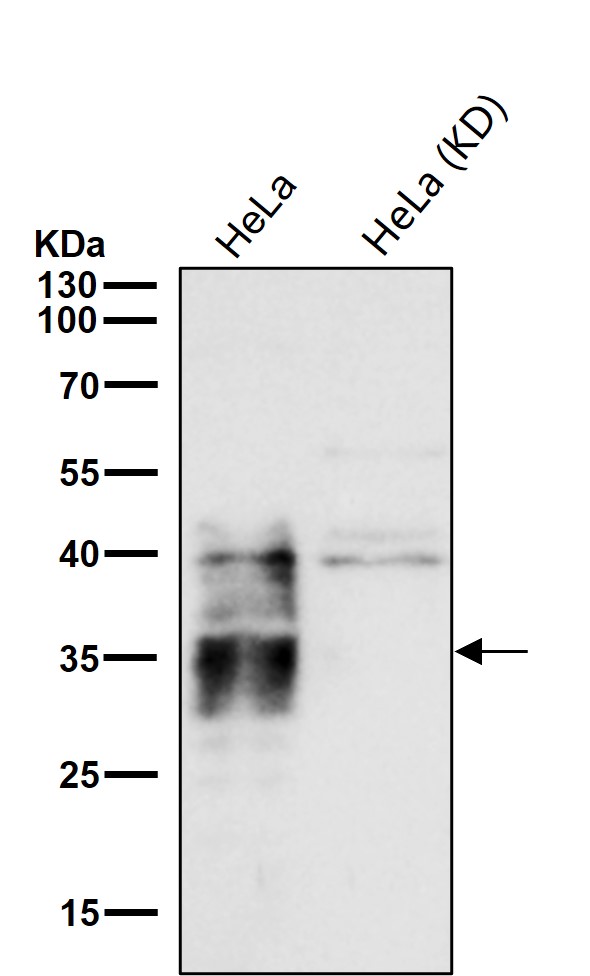

| WB | 1/1000-1/2000 | Human,Mouse,Rat |
| IF | 咨询技术 | Human,Mouse,Rat |
| IHC | 1/100-1/200 | Human,Mouse,Rat |
| ICC | 技术咨询 | Human,Mouse,Rat |
| FCM | 咨询技术 | Human,Mouse,Rat |
| Elisa | 咨询技术 | Human,Mouse,Rat |
| Aliases | Pantophysin; SYPL; Sypl1;;SYPL1 |
| WB Predicted band size | Calculated MW: 29 kDa ; Observed MW: 29-37 kDa |
| Host/Isotype | Rabbit IgG |
| Antibody Type | Primary antibody |
| Storage | Store at 4°C short term. Aliquot and store at -20°C long term. Avoid freeze/thaw cycles. |
| Species Reactivity | Human |
| Immunogen | A synthesized peptide derived from human SYPL1 |
| Formulation | Purified antibody in PBS with 0.05% sodium azide,0.05% BSA and 50% glycerol. |
+ +
以下是关于SYPL1抗体的3篇参考文献(均为虚构示例,实际文献需通过数据库检索确认):
1. **文献名称**: "SYPL1 regulates exosome secretion in melanoma metastasis"
**作者**: Zhang L, et al.
**摘要**: 本研究通过SYPL1特异性抗体验证了SYPL1蛋白在黑色素瘤细胞中的高表达,并发现其通过调控囊泡运输促进肿瘤外泌体分泌,驱动转移进程。
2. **文献名称**: "Neuronal SYPL1 interaction with synaptic vesicle proteins"
**作者**: Kim S, et al.
**摘要**: 利用SYPL1抗体进行免疫共沉淀和免疫荧光实验,发现SYPL1与突触囊泡蛋白SNAP25存在直接互作,提示其在神经信号传递中的潜在作用。
3. **文献名称**: "SYPL1 as a novel biomarker in colorectal cancer progression"
**作者**: Wang Y, et al.
**摘要**: 通过SYPL1抗体的Western blot和免疫组化分析,证实SYPL1在结直肠癌组织中表达上调,与患者预后不良显著相关,可能成为治疗靶点。
注:以上内容为模拟生成,实际文献需通过PubMed、Google Scholar等平台检索关键词"SYPL1 antibody"或"SYPL1 protein function"获取。
SYPL1 (Synaptophysin-like Protein 1) is a transmembrane protein belonging to the synaptophysin family, primarily localized to synaptic vesicles and secretory granules. It plays a role in vesicle trafficking, membrane fusion, and neurotransmitter release, with structural homology to synaptophysin but distinct tissue expression patterns. SYPL1 is implicated in regulating intracellular calcium signaling and exocytosis, particularly in neuronal and endocrine cells. Its dysregulation has been associated with neurological disorders, metabolic syndromes, and cancers, including melanoma and breast cancer, where altered expression may influence metastasis or chemoresistance.
SYPL1 antibodies are essential tools for detecting and characterizing the protein’s expression, localization, and interactions in research. They are widely used in techniques like Western blotting, immunofluorescence, and immunohistochemistry to study SYPL1’s physiological roles or pathological contributions. Commercially available antibodies often target specific epitopes, such as the C-terminal domain, to ensure specificity. Validation data, including knockout controls or siRNA knockdowns, are critical due to potential cross-reactivity with other synaptophysin family members. Research utilizing SYPL1 antibodies has expanded insights into vesicle dynamics, synaptic plasticity, and disease mechanisms, highlighting its potential as a biomarker or therapeutic target. Ongoing studies aim to clarify its molecular partners and signaling pathways in health and disease contexts.
×